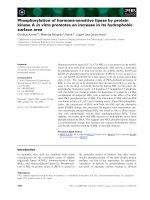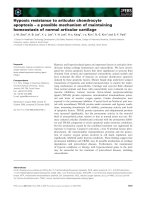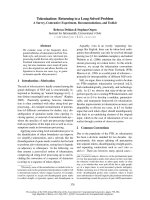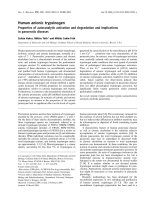Báo cáo khoa học: An answer to a question by Wilf on packing distinct patterns in a permutation potx
Bạn đang xem bản rút gọn của tài liệu. Xem và tải ngay bản đầy đủ của tài liệu tại đây (71.73 KB, 4 trang )
An answer to a question by Wilf on packing distinct
patterns in a permutation
Micah Coleman
∗
Submitted: Apr 21, 2004; Accepted: May 12, 2004; Published: May 24, 2004
MR Subject Classifications: 05A05, 05A16
Abstract
We present a class of permutations for which the number of distinctly ordered
subsequences of each permutation approaches an almost optimal value as the length
of the permutation grows to infinity.
1 Introduction
Definition 1.1 Let q = q
1
q
2
q
k
∈ S
k
be a permutation, and let k ≤ n. We say that
the permutation p = p
1
p
2
···p
n
∈ S
n
contains the pattern q if there is a set of indices
1 ≤ i
1
<i
2
< ···<i
k
≤ n such that p
i
1
<p
i
2
< ···<p
i
k
.
There has been significant interest in the topic of finding permutations containing
many copies of the same pattern. In this paper, we will be concerned with the other
extremity, permutations containing as many different patterns as possible.
At the Conference on Permutation Patterns, Otago, New Zealand, 2003, Herb Wilf
asked how many distinct patterns could be contained in a permutation of length n.Based
on empirical evidence, it seemed this number may approach the theoretical upper bound
of 2
n
. In this paper we enumerate patterns contained in each of a certain class of permu-
tations to at least establish a lower bound for this function.
Let f(p) be the number of distinct patterns contained in a permutation p.Leth(n)
be the maximum f(p), where the maximum is taken over all permutations of length n.
∗
Department of Mathematics, University of Florida, Gainesville FL 32611-8105. Supported by a grant
from the University of Florida University Scholars Program, mentored by Mikl´os B´ona.
the electronic journal of combinatorics 11 (2004), #N8 1
On the one hand,
n
k=0
n
k
=2
n
is an obvious upper bound for h(n). On the other hand,
there are only k! patterns of length k. So, for small k, we can replace
n
k
with k!. As n
grows, this second bound quickly becomes insignificant, as
n
k
<k!
for all k above a breakpoint which grows much slower than n.
Wilf demonstrated a class of permutations W
n
for which f(W
n
) asymptotically is
greater than (
1+
√
5
2
)
n
Let W
n
denote the n-permutation 1 n 2 n − 1 ···
n+1
2
.LetW
n
denote the
n-permutation n 1 n − 13 ···
n+1
2
. W
n
is called the complement of W
n
.Thei
th
entry of W
n
is larger than the j
th
entry of W
n
if and only if the j
th
entry of W
n
is larger
than the i
th
entry of W
n
.So,W
n
contains a pattern q if and only if W
n
contains the
complement q
. Therefore,
f(p
1
p
2
··· p
n
)=f(n − p
1
+1 n − p
2
+1 ··· n − p
n
+1)
It should also be noted that the subsequence W
n
containing the 2
nd
through n
th
entries
is the complement of W
n−1
. Then, the number of patterns contained in W
n
which do not
include the first entry is f(W
n−1
)=f(W
n−1
). The number of patterns contained in W
n
which are required to include the first entry but are distinct from those just enumerated
is f (W
n−2
). If f (W
n
)=f(W
n−1
)+f(W
n−2
) then the sequence W
1
,W
2
, is at least a
Fibonacci sequence, where each point is the sum of the two previous points. In fact, this
sequence has a rate of growth greater than the golden ratio
1 +
√
5
2
, the (eventual) rate of
growth of Fibonacci sequences.
In general, what can we say about L = lim sup
n
h(n)? Wilf’s result shows that
L ≥
1+
√
5
2
. Our result will show that L ≥ 2, so L = 2. So, in this sense, our result is
optimal. We establish this by presenting a class of permutations π
k
where f (π
k
) exceeds
2
(k−1)
2
.
We examined certain properties of all permutations up to length 10 and many be-
yond. A pleasantly surprising phenomenon was that
h(n+1)
h(n)
appears to be a monotonically
increasing function. The permutation
512271510413811161439
contains 16874 distinct patterns, more than 2
n−1
for n = 15. It seemed evident that
Wilf’s rate of growth could be improved upon.
2 The Construction
Definition 2.1 Let p be a permutation. We call an entry p
i
a descent if p
i
>p
i+1
.
the electronic journal of combinatorics 11 (2004), #N8 2
Theorem 2.2 For k ≥ 2, there exists a k
2
-permutation containing more than 2
(k−1)
2
distinct patterns
Proof: Let π
k
denote the permutation
k 2k k
2
(k −1) (2k −1) (k
2
−1) 1(k +1) (2k +1) (k
2
−k +1) ∈ S
k
2
For example,
π
3
=369 258 147
π
4
=481216 371115 261014 15913
It should be noted that the only descents in such a permutation are at the last entry
of each segment, descending to the first entry of the subsequent segment. As these points
play a significant role in our proof, we shall denote the first entry of each segment the
base of that segment.
Also, each segment is structured so that the i
th
entry of that segment is less than the
i
th
entry of each preceding segment.
As counting all patterns of such a permutation leads to overwhelming complexity,
we will restrict our attention to counting only certain patterns. Let k ≥ 2. For the
subsequences under consideration, we require that the first k entries of π
k
be included,
i.e., every entry in the first segment. Also, we include the base of each of the other
segments. Considering π
4
as an example, we require the following underlined entries to
be included.
4
8 12 16 3 71115 261014 15913
Requiring these 2k − 1 entries leaves k
2
− (2k − 1) = (k − 1)
2
entries remaining to
choose from. There are 2
(k−1)
2
subsets of these remaining entries. We claim that the
subsequences each of which is the union of the required entries and some subset of these
remaining entries are distinctly ordered, i.e., correspond to distinct patterns.
Suppose q = q
1
q
2
q
m
and r = r
1
r
2
r
m
are identically ordered subsequences of
this type, both of length m. Then, the descents in q and r must be at the same positions.
We required the base of each segment of π
k
to be included in q and r, so any descent will
immediately precede a base. Therefore, each base occupies the same position in q as in r.
This, in turn, implies that the i
th
entry of q lives in the same segment of π
k
as does the
i
th
entry of r, since they are situated between the same bases.
Furthermore, included in both q and r are all entries of the first segment of π
k
.Since
q and r are identically ordered, by definition, q
i
<q
j
⇐⇒ r
i
<r
j
.Iftherewassome
entry in the first segment of π
k
thatwaslessthansomeq
i
and greater than r
i
,thenq and
r would not be distinctly ordered as was assumed. As noted earlier, the i
th
entry of each
the electronic journal of combinatorics 11 (2004), #N8 3
segment of π
k
is less than the i
th
entry of π
k
itself. So, for all i, q
i
and r
i
occupy the same
position within the same segment and are, in fact, equal. Therefore, q coincides with r.
We’ve shown that two identically ordered subsequences must actually be the same, and
our claim follows that the 2
(k−1)
2
such subsequences constitute 2
(k−1)
2
distinct patterns.
Therefore, f(π
k
)=2
(k−1)
2
for all k ≥ 2. ✸
3 Long Distance Relationships
There is still much in this area to be explored. While the above class of permutations
lends itself to proof, like Wilf’s, it is a tradeoff between manageability and performance.
We have only counted a restricted number of patterns in certain less than optimal per-
mutations. The Holy Grail here would be tighter bounds for h(n).
A preferable result would be an inductive proof on n that for any permutation π of
length n, one could find a permutation of length n + 1 that contains π as well as at least
2f(π) patterns. This, with the upper bound, would be a clean proof that h(n)grows
asymptotically as 2
n
and allow for more understanding of how h(n) grows.
The aim for optimizing the permutation is typically to maximize the sum of the geo-
graphical and numerical distances between any two entries. For example, if q
i+1
= q
i
+1 in
a given permutation, then any subsequence q
j
1
···q
i
···q
j
k
wouldcorrespondtothesame
pattern as would q
j
1
···q
i+1
···q
j
k
. Maximizing the distances between entries minimizes
this sort of waste. That was how the above class of permutations was discovered, although
this property was not explicitly used in the proof.
References
[1] M. H. Albert, M. D. Atkinson, C. C. Handley, D. A. Holton, W. Stromquist, On
packing densities of permutations. Electron. J. Combin., 9(1) (2002), R5.
[2] M. B´ona, B. E. Sagan, V. Vatter, Frequency sequences with no internal zeros. Adv.
Appl. Math, 28 (2002), 395-420.
[3] D.Warren, Optimal Packing Behavior of some 2-block Patterns. Preprint, arXiv,
math.CO/0404113.
the electronic journal of combinatorics 11 (2004), #N8 4









